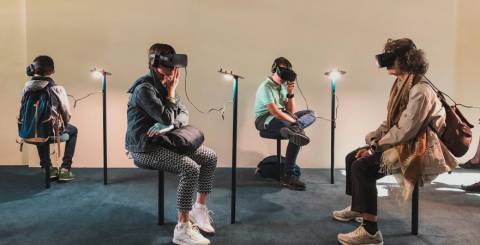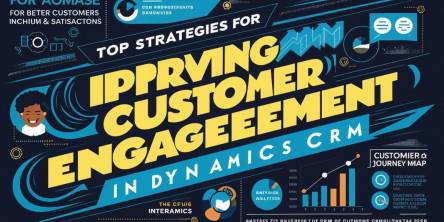The Impact of AR & VR on the Media and Entertainment Industry

Harnessing the latest technology to create and distribute content is an ongoing process in the media and entertainment industry. Changes in consumer behavior and demands, along with continuous and rapid technological advancements, are reshaping the industry. Technology is the key to driving these changes, from sophisticated special effects and streaming video platforms to online news and music.
AR and VR technologies have changed the course of media and entertainment by blurring the borders between reality and fantasy. They have brought the physical and digital domains closer than before and enhanced user experience. These technologies are being used more and more, and they have managed to replace in-person interactions with digital connections in entertainment, personal, and professional areas in many instances.
This article will discuss how AR and VR can be used to transform the media and entertainment industry.
Transformative trends in the M&E industry with AR / VR
• Interactive gaming: The AR and VR technologies offer immersive experiences to the gaming community. The technology lets gamers actively participate in the virtual gaming session. It takes gaming from a passive 2D experience to a more interactive and personal 3D experience that gives a more realistic and engaging feel while playing games. It also lets people socialize within the games, increasing the sense of community between players. These technologies are not just giving a better gaming experience but also changing how people interact and use media.
• Transforming cinema: The AR and VR technologies offer more immersive viewing to consumers that is beyond what has been conventionally experienced before. By using AR and VR, the viewers can virtually take an active part that changes the passive third-party storyline into a more personal and interactive experience. Augmented reality and virtual reality open new possibilities that allow the creation of interactive and virtual documentaries and movie sets. These technologies are not only changing how users watch movies or TV but are also transforming the way they are made.
• Events and concerts: Augmented reality and virtual reality are helping change how people can enjoy concerts and events by bringing the experience to them. Since the headsets are connected to the internet, they can let people enjoy live events from wherever they are. It helps create an immersive and engaging way of viewing such events that cannot be replicated by any other technology or conventional viewing methods. These technologies also enable new ways for organizers to generate global viewership and increase revenue, as these paid events can be viewed worldwide. AR and VR are not just helping enhance the event or concert but are also changing the way these events can be viewed.
• Training and education: AR and VR technologies offer immersive and interactive ways to learn and are rapidly getting into the training and education fields. These technologies can be used to learn complex concepts in a very personalized way that can help increase comprehension and retention of the subject. As an example, in a medical school, medical students can use AR and VR to practice surgeries in a very life-like virtual environment. Students can take tours of ancient civilizations or experience different countries and lifestyles in schools without leaving classrooms. The technology also enables remote learning, thus making education more accessible to people. AR and VR are changing how learning is conducted, normalizing it, and giving access to quality training and education.
• Social interaction: AR and VR technologies can be used to create virtual spaces or social interaction platforms that people can use to socialize or interact in real time. This is like using social media on mobile devices, except that AR and VR create digital personas in a digital environment, giving the impression of being there. This has created new possibilities for social media platforms and the gaming industry to create a sense of collaboration and community for the users. The experience of using AR or VR is much more expressive and can create a sense of immersive communication using virtual avatars. These technologies have changed the way people can connect with each other.
Final Words
These technologies' immersive nature has changed how the media and entertainment industry works and presents content. They enhance user experience and transform the way people can interact. Software solution development for the media industry can play an important role in creating and developing innovative AR and VR applications. By using the vast potential of these innovative AR and VR technologies, the media and entertainment industry is at a stage where they can unleash exciting, immersive entertainment.
Similar Articles
Among the solutions developed over the past few decades, Salesforce Financial Services Cloud (FSC) has emerged as the definitive choice for gaining flexibility, visibility, and long-lasting, inclusive growth in the financial sector.
Open source software (OSS) is distributed with its source code, which means it can be distributed, modified, and used freely with the original rights. Most users never see the source code, a critical part of the software.
It's one of the keystones, basic but key in the successful highly competitive modern business environment, where the connection with the customer is a must.
The speed of progress in the modern business landscape is quite relentless. For small-scale companies, this implies that keeping up with this progress is not simply gainful but fundamentally significant for their survival. And what does success in such an environment demand?
The finance sector needs to battle many difficulties in the modern and quick-moving digital landscape. Be it exploring the unpredictable snare of official guidelines or overseeing tremendous volumes of data - - financial establishments are feeling the pressure to succeed. This demanding environment, in turn, often leads to exhausted teams, costly manual errors, and inefficiencies that can be chalked up to repetitive tasks
The manufacturing industry, vital to the world economy, is at a pivotal intersection. I mean that, yet again, changes are afoot in the sector, this time driven by digital transformation as it represents a profound change in the very essence of how manufacturers operate, think, and drive innovation.
Technology helps make things easier and faster. Digitization is one of the aspects of technology that has changed how we live and work. It has brought many benefits for businesses, especially the travel industry. Customers can search online for the schemes offered and easily book trips, but payments need to be completed with ease.
In an article published by The Economist in 2017, while describing the astounding growth of titan companies like Google, Apple, Facebook, and Microsoft, it was mentioned how data had become “the oil of the digital era.”
In the modern, dynamic business environment, companies across the broad spectrum of sectors have become heavily dependent on vehicle fleets to sustain their activities. Whether it involves delivering crucial supplies, ferrying passengers, or supporting field service crews, effective fleet management is a fundamental pillar for success









